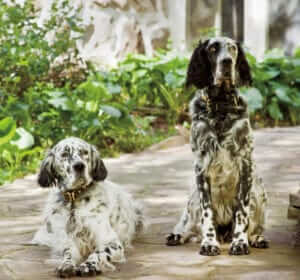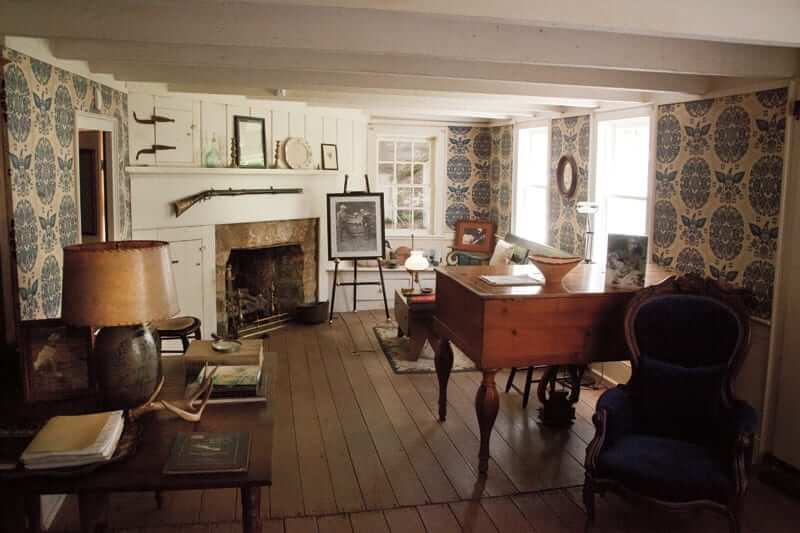Old Hemlock Foundation in Preston County carries a gentle legacy forward.
photographed by Carla Witt Ford
In 1939, a creative couple living in New York City bought an 18th century homestead in Preston County. A Pennsylvania-born illustrator of periodicals like Cosmopolitan and McCall’s Magazine, George Bird Evans had been raised to love bird dogs and the hunt. When he and his wife, Wheeling native Kathryn “Kay” Harris Evans, found their dream home, they left the city and made their lives in the country. They named their place Old Hemlock after a virgin hemlock stand on the property.
Over their six and seven decades at Old Hemlock, George and Kay stewarded their old log home and 230 acres, where they wrote mystery books under pseudonyms, among other things. Most importantly, George got back to hunting in earnest. He enjoyed shooting upland birds—birds like woodcock, grouse, and quail. In support of his pastime, he managed a conversion of former farmland on the property to woodlands. And he began breeding his own line of English setter hunting dogs.

Meanwhile, he thought a lot about the experience of hunting—the relationship between hunter, dog, and bird, and the mindset that makes the experience of taking a life have meaning. His writings made him an authoritative voice on upland bird hunting and quality bird dogs in magazines and, later, in a couple dozen books. “For Evans, hunting was not about the kill but about the entire experience,” reads the 2014 National Register of Historic Places nomination of the Old Hemlock property, noting that Evans’ philosophy was unconventional for the mid-20th century. “He believed that respect and fairness should come to play whenever a hunter entered the woods.” His book The Upland Shooting Life, published in 1971, brought him nationwide prominence.
George Evans died in 1998. His Old Hemlock English setters are now a sought-after breed. “They could win a conformation show at Westminster—they’re that pretty—but they’re hard hunters, they’re obedient, they’re not aggressive. Just a great all-around dog,” says Steve Smith, editor of The Pointing Dog Journal, who printed Evans’ writings. “If I didn’t have three dogs of my own right now, I’d be in the market to get one of George’s.” And admiration for his writings continues strong. One recent commenter on the Old Hemlock Foundation’s Facebook page wrote, “I still have an original book by George Evans in my library that I’ve read so many times.” Another: “When I first read [An Affair with Grouse], I didn’t put it down. I started again at chapter one and read it again.”

Kay Evans provided for creation of the Old Hemlock Foundation before she died in 2007. The foundation maintains the property as a wildlife preserve, as part of its conservation mission. Visitors can see the two-story log home and the stone studio George and Kay added in 1939, and they can tour the rooms where the couple sketched and wrote and lived a life close to nature. Some of the property’s 500 visitors a year are particularly appreciative. “I’ve had people visit Old Hemlock on their bucket list,” says foundation board member and administrator LeJay Graffious, a long-time friend of the Evanses. “I had a guy from Minnesota who’d had cancer. As soon as he was declared cancer-free, he made arrangements to spend the weekend with us.” The foundation also has a charitable side, supporting conservation efforts, the Preston County Humane Society, and college and medical school scholarships for local students. While the various activities generally promote the Evanses’ legacy, they all center around a philosophy of mindfulness and appreciation that particularly resonated with George Evans’ readers. “I think the biggest thing George promoted was the idea of the quality of the quest and experience,” Graffious says.
Evans’ manuscripts are housed at the West Virginia University Libraries, which Graffious says is scanning his hunting journals and expects to make them available online in searchable form later in 2016. As for manuscripts Evans submitted to Smith, they’re locked in a safe. “One of my great sorrows is that I worked with George from 1981 until his death and I never met him,” Smith says. “He’s been missed. I keep his memory alive by republishing his articles now and then, one or two a year.”
17098 Brandonville Pike, Bruceton Mills; oldhemlock.org; info@oldhemlock.org











Leave a Reply